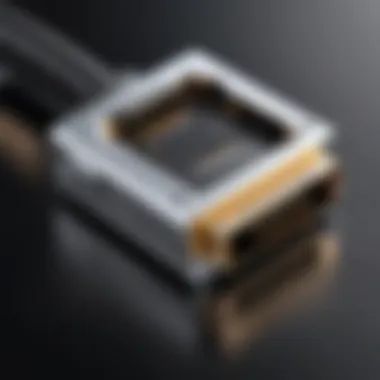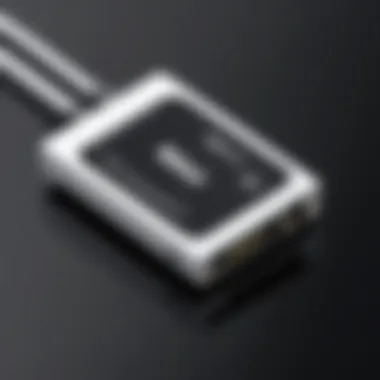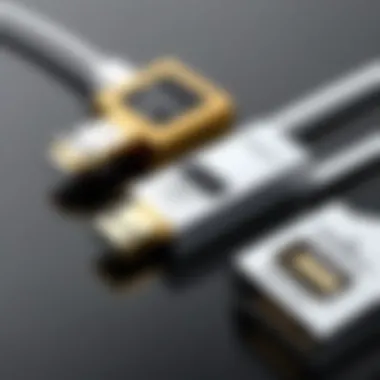Understanding Mini DisplayPort 1.4: Specifications and Benefits


Intro
Mini DisplayPort 1.4 is an important advancement in the realm of digital connectivity. This standard is particularly relevant for those who demand high-resolution output and efficient data transmission. In a landscape filled with various connection types, understanding Mini DisplayPort 1.4 allows for more informed choices in purchasing and utilizing technology. This overview will explore its specifications, unique advantages, and the role it plays in the modern digital ecosystem.
Product Overview
Brief Description
Mini DisplayPort 1.4 is a compact interface used for transmitting video and audio data from a source device to a display. Originally designed by Apple, it is now widely adopted across various platforms and devices, including laptops, desktops, and graphic cards. The standard is built to handle higher performance metrics than its predecessors, making it suitable for high-definition displays.
Key Features
- Resolution Support: It supports resolutions up to 8K at 60Hz.
- Enhanced Audio: Capable of transmitting multichannel audio formats.
- Bandwidth: Offers a maximum bandwidth of 32.4 Gbps.
- Backward Compatibility: Works with previous DisplayPort versions.
Available Variants
While Mini DisplayPort 1.4 is a specific standard, various cables and adapters are available for compatibility with other devices. This versatility allows users to connect a wide array of devices, making it a popular choice among tech enthusiasts.
Specifications Breakdown
Technical Specifications
Mini DisplayPort 1.4 operates with the following technical specifics:
- Display Stream Compression (DSC): Supports the use of DSC for higher resolutions without sacrificing quality.
- DisplayPort MST Hub: Capable of supporting multiple displays through a single output.
Performance Metrics
The performance metrics of Mini DisplayPort 1.4 highlight its efficiency. The 32.4 Gbps bandwidth ensures quality performance during high-resolution content streaming, and its ability to extend video output makes it a favored choice among professional users, as well as gamers.
Compatibility Information
This standard is compatible with a broad range of devices. It works seamlessly with latest graphics cards from Nvidia and AMD, along with multiple 8K displays. Mini DisplayPort 1.4 can also connect with Thunderbolt 3 devices, further expanding its usability.
Comparative Analysis
Competing Products
Mini DisplayPort faces competition from HDMI 2.1 and USB-C. Each interface has unique offerings, yet Mini DisplayPort 1.4 remains superior for high-refresh-rate gaming due to its low latency.
Strengths and Weaknesses
- Strengths:
- Weaknesses:
- High-resolution support.
- Low latency for gaming use.
- Limited adoption compared to HDMI.
- May require adapters for HDMI connection.
Price Comparison
Pricing for Mini DisplayPort cables vary significantly based on the brand and specifications. Generally, they fall within a reasonable price range compared to HDMI cables, but finding a high-quality option is crucial for maximizing benefits.
Buying Guide
Target User Profiles
Mini DisplayPort 1.4 is ideal for gamers, graphic designers, and anyone needing high-resolution displays. It’s suited for users who prioritize performance over cost.
Important Considerations
When purchasing Mini DisplayPort cables or devices, consider the following:
- Cable Length: Longer cables might result in signal loss.
- Quality: Always look for certified cables to ensure performance.


Insider Tips for Buyers
- Look for sales to acquire higher-end cables without breaking the bank.
- Read reviews to understand product performance from other users.
Maintenance and Upgrade Insights
Regular Maintenance Practices
To maintain device performance, keep the ports clean and avoid bending cables. Checking for software updates on connected devices may also help in optimizing performance.
Upgrade Paths and Options
If performance needs change, consider upgrading to newer displays that support Mini DisplayPort 2.0 or adopting a monitor with Thunderbolt 3 ports for added flexibility.
Troubleshooting Common Issues
Common issues may include connection failures or display problems. Ensure cables are securely connected, and reboot devices if problems persist. Checking for updates can resolve compatibility issues.
In summary, Mini DisplayPort 1.4 represents a crucial standard in modern digital connectivity, balancing performance and versatility for a wide range of users. Engaging with this technology not only enhances your current setup but also prepares for future advancements.
Prolusion to Mini DisplayPort 1.
Mini DisplayPort 1.4 plays a crucial role in the connectivity landscape of modern devices. As technology evolves, the need for efficient, high-quality connections between displays and computers becomes more pressing. Mini DisplayPort 1.4 addresses this need by offering advanced specifications that facilitate superior data transfer rates and support high-resolution displays.
The importance of this version lies not only in its technical capabilities but also in its widespread adoption across various devices. Many laptops, monitors, and graphics cards now incorporate Mini DisplayPort 1.4, making it a standard in professional and gaming setups.
Key Elements of Mini DisplayPort 1.
Understanding the key elements of Mini DisplayPort 1.4 can help users make informed decisions regarding their technology purchases.
- Higher Bandwidth: Mini DisplayPort 1.4 supports up to 32.4 Gbps. This bandwidth enhances the ability to transmit more data simultaneously, making high-resolution video output feasible.
- Support for 8K Resolution: With the capability to manage 8K video at 60Hz through Display Stream Compression (DSC), it becomes essential for users who prioritize high-definition visuals.
- Audio Support: Mini DisplayPort 1.4 supports multiple audio channels, providing users with an immersive audio experience alongside their video content.
The understanding of these elements fosters a greater appreciation for the advantages offered by Mini DisplayPort 1.4, especially for enthusiasts who require cutting-edge performance from their technology.
Benefits of Mini DisplayPort 1.
By employing Mini DisplayPort 1.4, users can benefit from the following:
- Increased Versatility: It is compatible with various display technologies and adapters, making it easier to connect different devices.
- Enhanced Performance: Users can expect a smoother experience when multitasking or gaming due to high data transfer rates.
- Future-Proofing: Choosing technologies like Mini DisplayPort 1.4 ensures that systems remain capable of handling future upgrades in display technology.
Considerations for Users
When delving into Mini DisplayPort 1.4, users must consider their specific requirements. For instance, those working in design or gaming might prioritize the highest resolutions and refresh rates available, while general users may find that previous versions suffice for their needs. Understanding these considerations can lead to more efficient and satisfying technology choices.
Historical Context of Mini DisplayPort
The historical context of Mini DisplayPort is essential for understanding its development and significance in modern technology. The evolution of this interface reflects the rapidly changing demands of digital connectivity. Mini DisplayPort has emerged as a key player in the ecosystem of audio and visual technology. Its design and functionality respond to the needs for high-resolution displays and efficient data transfer, which are critical in today’s digital landscape.
Early Developments
The origins of Mini DisplayPort can be traced back to the increasing need for versatile display connectivity. Originally, the DisplayPort standard was developed by the VESA (Video Electronics Standards Association) in 2006. It aimed to establish a new way for transmitting audio and video between devices while supporting high resolutions and refresh rates. The Mini DisplayPort variant was introduced by Apple in 2008, specifically designed to provide a more compact connector without compromising performance.
The early iterations of DisplayPort included features such as HDCP (High-bandwidth Digital Content Protection) and support for multiple channels of audio. Mini DisplayPort capitalized on these features but aimed to deliver them in a smaller form factor, suitable for portable devices. This decision was crucial for laptops and other compact devices, solidifying its role in mobile computing.
Evolution to Mini DisplayPort 1.
With the launch of Mini DisplayPort 1.4 in 2016, several improvements were introduced over its predecessors. This version focused on augmenting bandwidth capabilities, allowing for higher resolutions and better refresh rates. It supports resolutions up to 8K at 60Hz and allows dual 4K displays simultaneously. Such advancements cater to the increasing demand for high-definition content and multi-monitor setups in various fields, including gaming, professional design, and multimedia production.
Mini DisplayPort 1.4 also integrated support for HDR (High Dynamic Range) video, enhancing color accuracy and contrast. This feature aligns with trends toward immersive viewing experiences found in modern TVs and monitors. The evolution of Mini DisplayPort 1.4 reflects a growing emphasis on versatile, high-quality connections in an ever-evolving digital environment.
Significant advancements in Mini DisplayPort 1.4 have made it a crucial interface for high-performance displays in a variety of professional and consumer contexts.
Technical Specifications of Mini DisplayPort 1.
Understanding the technical specifications of Mini DisplayPort 1.4 is crucial for grasping its role in modern connectivity solutions. These specifications dictate how the technology operates and how it facilitates communication between devices. A firm understanding of these elements helps users make informed decisions regarding their hardware and optimize their tech experience.


Bandwidth and Data Transfer Rates
Mini DisplayPort 1.4 offers a significant bandwidth of 32.4 Gbps. This is a notable improvement over its predecessor, Mini DisplayPort 1.2, which supported only 21.6 Gbps. Enhanced bandwidth allows Mini DisplayPort 1.4 to handle more data simultaneously, thereby improving overall performance. Such a high data rate is instrumental in supporting high-resolution displays and refresh rates.
With increased bandwidth, users can experience rich visual content with minimal latency. It supports resolutions up to 8K at 60Hz, and this capability is particularly beneficial for gamers and content creators who require top-notch graphics. The high data transfer rates also facilitate smoother video playback and an overall more fluid experience when using multiple monitors.
Supported Resolutions and Refresh Rates
An exemplary aspect of Mini DisplayPort 1.4 is its support for multiple resolutions and refresh rates. This technology supports:
- 8K (7680x4320) at 60Hz,
- 4K (3840x2160) at 120Hz, and
- 1440p at refresh rates beyond 144Hz for gaming.
Such resolutions and refresh rates improve visual fidelity and responsiveness. For tech enthusiasts, this means that gaming and watching videos become immersive experiences. Additionally, having support for various resolutions lets users easily connect different displays without sacrificing quality.
Audio Capabilities
Mini DisplayPort 1.4 also includes advanced audio features. It supports up to 32 audio channels, which enhances the surround sound experience. This capability is crucial for applications such as virtual reality, gaming, and home theater systems.
Moreover, it can handle audio formats like Dolby Atmos and DTS:X. These audio formats provide a richer listening experience, making it essential for audiophiles and gaming enthusiasts.
In summary, the technical specifications of Mini DisplayPort 1.4 highlight its capacity for high bandwidth, extensive resolutions, and advanced audio capabilities. Understanding these features allows users to harness the full potential of their devices in today’s digital landscape.
Comparison with Previous Versions
Understanding the differences betwen Mini DisplayPort 1.4 and its predecessors is crucial for both consumers and tech professionals. These comparisons shed light on the enhancements that each version brings, helping stakeholders make informed decisions. Mini DisplayPort has evolved to meet the growing demands for higher bandwidth and better connectivity options.
Mini DisplayPort 1.
vs Mini DisplayPort 1.
Mini DisplayPort 1.2 was a significant upgrade from its predecessor, but 1.4 introduced critical innovations. Both versions serve the main purpose of connecting displays efficiently. However, the implements found in 1.4 elevate the potential considerably.
First, the bandwidth in Mini DisplayPort 1.2 is 21.6 Gbps, while Mini DisplayPort 1.4 supports up to 32.4 Gbps. This increase means that 1.4 can handle higher resolutions and refresh rates. Users can work with 8K resolutions at 60Hz, something not possible with 1.2.
- The primary enhancements in Mini DisplayPort 1.4 include:
- Support for Display Stream Compression (DSC) technology.
- HDR (High Dynamic Range) support for improved color depth and brightness.
- Enhanced audio capabilities for immersive sound experiences.
These features make Mini DisplayPort 1.4 a better choice for gamers, graphic designers, and any users who demand high performance.
Mini DisplayPort 1.
versus HDMI and DisplayPort
When comparing Mini DisplayPort 1.4 to HDMI and standard DisplayPort, several factors arise. Both HDMI and DisplayPort have their unique strengths, but Mini DisplayPort maintains advantages that cater to specific user needs.
Mini DisplayPort 1.4 excels in bandwidth, as mentioned previously. Standard HDMI, particularly versions prior to 2.1, may struggle with high resolution due to lower bandwidth capabilities. However, HDMI 2.1 also supports 8K resolutions while offering eARC for enhanced audio return channel.
On the other hand, standard DisplayPort is also capable of high performance. Mini DisplayPort’s smaller size makes it ideal for portable devices, whereas DisplayPort is commonly found in desktop settings.
In summary, the choice between these interfaces depends on the specific use case:
- If you require higher resolution and refresh rates, Mini DisplayPort 1.4 may be preferred.
- For versatile audio-video integration, especially for home theater systems, HDMI is advantageous.
- Standard DisplayPort works effectively in larger setups requiring multiple connections.
Overall, Mini DisplayPort 1.4's advancements over previous versions position it as a robust solution for modern connectivity challenges, making it a valuable choice in today's tech landscape.
Practical Applications of Mini DisplayPort 1.
Mini DisplayPort 1.4 has found its place as a vital component in modern technology. It is not just about the specifications; its practical applications are key to understanding its significance. This section explores various elements such as connecting monitors, utilizing it in laptops and desktops, and its compatibility with adapters. Each of these facets reveals how Mini DisplayPort 1.4 enhances the overall user experience in diverse settings.
Connecting Monitors
One of the primary applications of Mini DisplayPort 1.4 is its role in connecting monitors. It supports high display resolutions and refresh rates, which is crucial for users looking for clarity and smoothness. Whether for professional graphic design work or gaming, having that capability matters. For instance, it can handle 8K resolutions at 60Hz, making it an excellent choice for high-end displays.


Additionally, the implementation of Display Stream Compression (DSC) allows users to transmit high-fidelity video at lower bandwidths without noticeable loss. This is especially advantageous in multi-monitor setups, where bandwidth can be an issue. The versatility in connectivity means one can connect not only standard monitors but also high-refresh-rate displays, making Mini DisplayPort 1.4 an attractive choice for various applications.
Use in Laptops and Desktops
Mini DisplayPort 1.4 is prevalent in laptops and desktops, providing a robust solution for connecting to external displays. Many modern laptops, including the Apple MacBook line, integrate this technology seamlessly. Its compact form factor is ideal for portable devices, which often prioritize space efficiency without sacrificing performance.
Desktops benefit as well, with Mini DisplayPort 1.4 facilitating easy upgrades. Users can quickly connect multiple high-resolution displays to enhance their workflow or gaming experience. The ability to daisy chain multiple monitors using Multi-Stream Transport (MST) technology further adds to its usability. This feature is particularly relevant for gamers and professionals who require an immersive and expansive workspace.
Compatibility with Adapters
The compatibility of Mini DisplayPort 1.4 with a wide array of adapters is another significant aspect. Users can easily connect to HDMI, DVI, or VGA displays, broadening the potential for various setups. This flexibility holds great value, especially for those transitioning from older systems or integrating newer technology into existing infrastructures.
The ability to use adapters with Mini DisplayPort 1.4 gives users freedom to choose how to connect various display technologies, preserving their existing hardware investments.
Through thoughtful design, the Mini DisplayPort ecosystem encourages users to maintain versatility in connecting devices. As technology advances further, this adaptability ensures longevity and relevance in a rapidly changing market.
Challenges and Limitations
Understanding the challenges and limitations of Mini DisplayPort 1.4 is crucial for individuals who wish to use this technology effectively. While this standard brought significant improvements over its predecessors, it is essential to recognize the specific obstacles that may arise in practical use. Addressing these issues helps users make informed choices and ensures optimum performance when connecting devices.
Device Compatibility Issues
One of the most notable challenges concerning Mini DisplayPort 1.4 is device compatibility. Not every device supports this standard, leading to potential connectivity problems. When using older laptops or monitors that only support Mini DisplayPort 1.2 or earlier versions, users may face limitations in performance and functionality.
For example, a user connecting a modern graphics card that supports Mini DisplayPort 1.4 to an older monitor may not be able to utilize the full capabilities of that graphics card. The maximum resolution, refresh rate, and audio data may be reduced as the older device cannot process the increased bandwidth of Mini DisplayPort 1.4. Users must verify compatibility before purchasing equipment to avoid these frustrations.
A thorough understanding of device specifications is vital to ensuring seamless connectivity without loss of performance.
Cable Quality and Performance
Another significant limitation relates to the quality of cables used with Mini DisplayPort 1.4. Not all cables are created equal. Using low-quality cables can lead to poor signal integrity, resulting in degraded video and audio performance. This issue can manifest as flickering images, audio dropouts, or even complete loss of signal.
Furthermore, longer cable lengths can exacerbate these issues. As the distance increases, the signal may weaken, making it essential to choose high-quality cables designed to maintain performance over longer runs. Users should consider purchasing cables certified for Mini DisplayPort 1.4 to ensure reliable data transmission.
Future of Mini DisplayPort Technology
The landscape of technology is always evolving. As such, the future of Mini DisplayPort technology holds substantial significance. Understanding where this standard is heading not only helps the tech community keep abreast of advancements but also informs decision-making regarding future purchases.
Mini DisplayPort 1.4 has already showcased remarkable capabilities, such as impressive bandwidth and resolution support. With new generation displays and devices continually emerging, future versions may enhance these features even further. By exploring potential changes and enhancing connectivity options, professionals, gamers, and tech enthusiasts can properly assess their needs for the future.
Emerging Trends
The advancement in display technology is not only rapid but also transformative. Thus, some trends are becoming increasingly relevant in the context of Mini DisplayPort. One significant trend is the integration of Mini DisplayPort with other standards like Thunderbolt 3. This fusion is noteworthy as it combines data transfer and display output into a single cable.
Additionally, the rise of 8K displays necessitates new standards that can accommodate greater data throughput. Therefore, Mini DisplayPort must adapt to maintain its relevance in the high-resolution display arena. Support for HDR (High Dynamic Range) is also becoming essential, enhancing users' experiences with better color representation and brightness.
Moreover, the shift towards wireless technologies is noticeable. Though Mini DisplayPort is a wired standard, the push for wireless display solutions may spur new innovations that improve compatibility and performance.
Predicted Advancements
While emerging trends indicate where the technology might go, predicted advancements can provide even more targeted insights. One notable speculation is that future iterations will increase bandwidth and support even higher resolutions, possibly up to 16K. This would align well with the increasingly demanding requirements of professional creators and gamers.
Another expected advancement involves the refinement of audio capabilities. Currently, Mini DisplayPort supports integrated audio, but future versions may provide enhanced surround sound formats or even lossless audio streaming.
Furthermore, improvements in adapter technologies could facilitate better interoperability among different device types. Enhanced chipsets that minimize latency and maximize transmission efficiency are likely to become the norm.
"The evolution of Mini DisplayPort technology will shape how we connect and communicate with our devices."
Finale
The conclusion section of this article encapsulates the essence of Mini DisplayPort 1.4 and its place in contemporary technology. Understanding this connector is more than recognizing its specifications. It involves grasping how it facilitates connectivity among devices in a fast-evolving digital landscape.
Importance of Mini DisplayPort 1.4 lies in its ability to deliver high-performance audio and video. This standard supports resolutions up to 8K and impressive refresh rates, making it essential for gamers and professionals alike. Its versatility in connecting multiple displays is a remarkable feature that appeals to various users, from business professionals to entertainment enthusiasts.
Key benefits include superior bandwidth, which allows for the transmission of large amounts of data efficiently. This is crucial for applications that demand high fidelity and quick response times. Furthermore, Mini DisplayPort 1.4 is backward compatible, enhancing its appeal as users can connect it with older devices without compromising quality.
Consideration of future advancements in this technology shows promise. As digital media continues to flourish, the demand for superior connectivity will likely increase. Users must stay informed about upcoming trends and innovations related to Mini DisplayPort, as this knowledge can guide better purchasing and usage decisions.
In summary, the conclusion of this article emphasizes the significance of Mini DisplayPort 1.4 in connecting modern devices, providing insights that are relevant for tech enthusiasts, gamers, and DIY builders. This underlines the need for well-informed decisions in an environment that is always advancing. Overall, comprehending Mini DisplayPort 1.4 not only enriches the user's understanding but also enhances their experience in utilizing today's technology.
A thorough understanding of Mini DisplayPort 1.4 equips users with the knowledge to make informed choices and maximize the performance of their devices.



